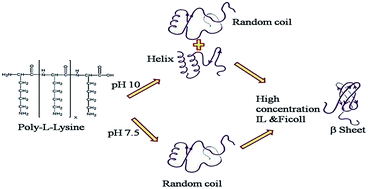Micro-viscosity induced conformational transitions in poly-l-lysine
Abstract
Protein aggregation triggered by conformational changes is considered to be one of the major reasons for neuro-degenerative diseases like Alzheimer's and Parkinson's. Poly-L-lysine (PLL) undergoes the α-helix-to-β-sheet transition which is considered as characteristic of protein aggregation. Understanding the role of viscosity in triggering these transitions is the main objective of this paper, and we have found out the ionic liquid 1-ethyl-3-methylimidazolium ethyl sulfate (IL-emes) and Ficoll induce such transitions in PLL, by using various techniques including circular dichroism, quartz crystal microbalance (QCM), tensiometry and Transmission Electron Microscopy (TEM). Irrespective of pH, viscosity tunes the native conformations of PLL to beta sheet conformations. Thioflavin T binding to PLL shows that these β-sheets are amyloidogenic. At the liquid/air interface, due to destabilization of the α-helical conformation of PLL at pH 10 with increasing concentrations of ionic liquid, an increase in surface activity is observed. TEM analysis shows macromolecular assemblies of PLL in ionic liquid and Ficoll. This work is an attempt to give an analogy between viscosity and conformational changes of PLL and thus can serve as a guide for protein aggregation in neuro-degenerative diseases. Taking PLL as a model, correlation between molecular properties like conformation and viscosity, a macroscopic property has been made.


 Please wait while we load your content...
Please wait while we load your content...